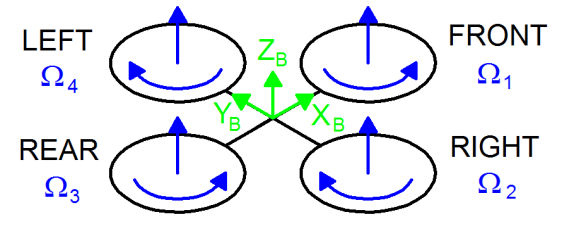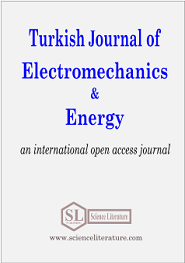
Robust control of a quadcopter using PID and H∞ controller
Abstract
In this article, two control units, the proportional integral derivative (PID) and robust H∞ controller, are designed for controlling a quadcopter. The drone is a multi-input multi-output (MIMO) system whose control requires a lot of precision and durability. The objective of the control system is to ensure the tracking of the desired trajectory with precision in the face of the exogenous inputs (disturbance) which can affect the correct operation of the quad-copter. Support for harsh operating conditions due to model uncertainties that cause errors during operation. For this reason, controlling quad-copters is considered difficult and complex, which requires a compact and robust design. In this research we will study the design of a robust H∞ controller based on optimal control, this technique is widely used in the control of multivariable systems. Then the robust H∞ controller obtained is compared with a PID controller to justify the robustness of the H∞ controller and the efficiency of the behaviour of the quad-copter with H∞ concerning disturbances. The results of the simulation using MATLAB/Simulink showed the effectiveness of the method with acceptable trajectory tracking.
Full Text:
PDFReferences
N. Michael, J. Fink, and V. Kumar, “Cooperative manipulation and transportation with aerial robots,” Autonomous Robots, 30(1), pp. 73-86, 2011.
Z. Tahir, W. Tahir, and S. A. Liaqat, "State space system modelling of a quadcopter UAV," arXiv preprint arXiv:1908.07401, 2019.
C. C. Chen, and Y. T. Chen, "Feedback linearized optimal control design for a quadrotor with multi-performances," IEEE Access, vol. 9, pp. 26674-26695, 2021.
N. P. Nguyen, and S. K. Hong, “Sliding mode thau observer for actuator fault diagnosis of quadcopter UAVs,” Applied Sciences, 8(10), pp. 1893, 2018.
S. Bouabdallah, and R. Siegwart, "Backstepping and sliding-mode techniques applied to an indoor micro quadrotor," IEEE international conference on robotics and automation, Barcelona, Spain, 2005, pp. 2247-2252.
M. Karahan, and C. Kasnakoglu, "Modeling and simulation of quadrotor UAV using PID controller." 11th ECAI Conferencance, Pitesti, Romania, 2019, pp. 1-4.
G. T. Navajas, and S. R. Prada, "Building your own quadrotor: A mechatronics system design case study," III. International Congress of Engineering Mechatronics and Automation, Cartagena, Colombia, 2014, pp. 1-5.
V. Praveen, and S. Pillai, “Modeling and simulation of quadcopter using PID controller,” International Journal of Control Theory and Applications, 9(15), pp. 7151-7158, 2016.
L. Abdou, "Integral backstepping/LFT-LPV H∞ control for the trajectory tracking of a quadcopter," 7th International Conference on Systems and Control, 2018, pp. 348-353.
C. Massé, O. Gougeon, D.-T. Nguyen and D. Saussié, "Modeling and control of a quadcopter flying in a wind field: A comparison between LQR and structured ℋ∞ control techniques," International Conference on Unmanned Aircraft Systems (ICUAS), 2018, pp. 1408-1417.
M. De Freitas Virgilio Pereira, “Constrained Control for Load Alleviation in Very Flexible Aircraft,” PhD. Thesis, University of Michigan, 2022.
Y. Naidoo, R. Stopforth, and G. Bright, “Quad-Rotor unmanned aerial vehicle helicopter modelling & control,” International Journal of Advanced Robotic Systems, 8(4), pp. 45, 2011.
Z. M. Carlton, “System Identification and Verification of Rotorcraft UAVs,” Ph.D. Thesis, University of Cincinnati, 2017.
P. Moonumca, Y. Yamamoto, and N. Depaiwa, "Adaptive PID for controlling a quadrotor in a virtual outdoor scenario: Simulation study," International Conference on Mechatronics and Automation, 2013, pp. 1080-1086.
S. Bouabdallah, A. Noth, and R. Siegwart, "PID vs LQ control techniques applied to an indoor micro quadrotor." International Conference on Intelligent Robots and Systems, 2004, pp. 2451-2456.
H. Bolandi, M. Rezaei, R. Mohsenipour et al., “Attitude control of a quadrotor with optimized PID controller,” Intelligent Control and Automation, 4(3), pp. 335-342, 2013.
A. Noormohammadi-Asl, O. Esrafilian, M. A. Arzati et al., “System identification and H∞-based control of quadrotor attitude,” Mechanical Systems and Signal Processing, vol. 135, pp. 106358, 2020.
B. J. Emran, “Globally robust tracking control of a quadrotor aerial vehicle for multi-behaviour applications,” PhD. Thesis, University Of British Columbia (Okanagan, 2019.
S. L. Rangajeeva, and J. F. Whidborne, "Linear parameter varying control of a quadrotor," 6th International Conference on Industrial and Information Systems, 2011, pp. 483-488.
R. W. Beard, “Quadrotor dynamics and control,” Brigham Young University, Tech. Report, vol. 19, pp. 46-56, 2008.
M. Kerma, A. Mokhtari, B. Abdelaziz et al., “Nonlinear H∞ control of a quadrotor (UAV), using high order sliding mode disturbance estimator,” International Journal of Control, 85(12), pp. 1876-1885, 2012.
A. Manjunath, P. Mehrok, R. Sharma et al., "Application of virtual target based guidance laws to path following of a quadrotor UAV," International conference on unmanned aircraft systems (ICUAS), 2016, pp. 252-260.
C. Coza, C. Nicol, C. Macnab et al., “Adaptive fuzzy control for a quadrotor helicopter robust to wind buffeting,” Journal of Intelligent & Fuzzy Systems, 22(5-6), pp. 267-283, 2011.
R. Guardeño, M. J. López, and V. M. Sánchez, “MIMO PID controller tuning method for quadrotor based on LQR/LQG theory,” Robotics, 8(2), pp. 36, 2019.
M. Manimaraboopathy, H. V. Christopher, and S. Vignesh, “Unmanned fire extinguisher using quadcopter,” International Journal on Smart Sensing and Intelligent Systems, 10(5), pp. 471-481, 2017.
M. H. Guisser, and H. Medromi, “Commande robuste en temps discret d’un robot volant quadrirotor en présence de vent,”
WOTIC'09 Conference, Agadir, Morocco, December 2009.
Y. Chen, Y. He, and M. Zhou, “Modeling and control of a quadrotor helicopter system under impact of wind field,” Research Journal of Applied Sciences, Engineering and Technology, 6(17), pp. 3214-3221, 2013.
L. Cedro, and K. Wieczorkowski, “Optimizing PID controller gains to model the performance of a quadcopter,” Transportation Research Procedia, vol. 40, pp. 156-169, 2019.
B. Kamel, B. Yasmina, B. Laredj et al., "Dynamic modeling, simulation and PID controller of unmanned aerial vehicle UAV," Seventh International Conference on Innovative Computing Technology (INTECH), 2017, pp. 64-69.
L. E. Romero, D. F. Pozo, and J. A. Rosales, “Quadcopter stabilization by using PID controllers,” Maskana, vol. 5, pp. 175-186, 2014.
L. Zhou, A. Pljonkin, and P. K. Singh, “Modeling and PID control of quadrotor UAV based on machine learning,” Journal of Intelligent Systems, 31(1), pp. 1112-1122, 2022.
R. Çelikel, M. Özdemir, and Ö. Aydoğmuş, “Implementation of a flywheel energy storage system for space applications,” Turkish Journal of Electrical Engineering and Computer Sciences, 25(2), pp. 1197-1210, 2017.
A. G. Varghese, and D. Sreekala, “Modeling and design of UAV with LQG and H∞ controllers,” International Journal of Engineering Research & Technology (IJERT), 8(5), pp. 446-450, 2019.
T. M. I. Hakim, and O. Arifianto, "Implementation of Dryden continuous turbulence model into Simulink for LSA-02 flight test simulation," Journal of Physics: Conference Series, IOP Publishing, 2018, pp. 012017.
T. Kang, K. J. Yoon, T.-H. Ha and G. Lee “H-infinity control system design for a quad-rotor,” Journal of Institute of Control, Robotics and Systems, 21(1), pp. 14-20, 2015.
P. Priya, and S. S. Kamlu, "Robust Control Algorithm for Drones," Aeronautics-New Advances: Intech Open Pabl., 2022.
A. Jafar, S. Fasih-UR-Rehman, S. Fazal-UR-Rehman, N. Ahmed, and M. U. Shehzad, "A robust H∞ control for unmanned aerial vehicle against atmospheric turbulence," 2nd International Conference on Robotics and Artificial Intelligence (ICRAI), 2016, pp. 1-6.
URN: https://sloi.org/urn:sl:tjoee81272
Copyright (c) 2023 Turkish Journal of Electromechanics and Energy

This work is licensed under a Creative Commons Attribution-NonCommercial 4.0 International License.

 Indexed in:
Indexed in:
















